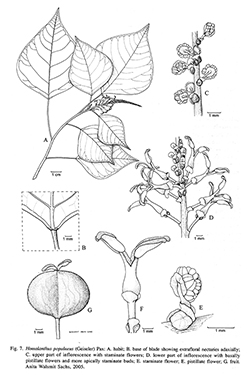e-Flora of Thailand
Volume 8 > Part 2 > Year 2007 > Page 334 > Euphorbiaceae > Homalanthus
Homalanthus populneus (Geiseler) Paxwfo-0000983012
in Engl. & Prantl, Nat. Pflanzenfam. 3, 5: 96, excl. fig. 60. 1890; Pax & K.Hoffm. in Engl., Pflanzenr. IV. 147. v: 46. 1912; Airy Shaw, Kew Bull. 26: 281. 1972; Whitmore, Tree Fl. Malaya 2: 102. 1973; Esser, Blumea 42: 453, map 9. 1997. Geiseler, Croton. Monogr.: 80. 1807.Stillingia populnea Geiseler, Croton. Monogr.: 80. 1807.— Carumbium populneum (Geiseler) Müll.Arg. in DC., Prodr. 15, 2: 1144. 1866. Fig. 7.
Accepted Name : This is currently accepted.
Synonyms & Citations :
Description : Tree up to 10 m high; glabrous. Stipules 0.8–2 cm long. Leaves: petiole 1–15 cm long, glandless; lamina broadly ovate to deltoid, 3–22 by 1.5–20 cm, length/width ratio 0.8–4.6, base rounded to slightly emarginate, not or indistinctly (up to 1 mm) peltate, with 2 or a single confluent gland above, apex acuminate, abaxially usually with 1–3 submarginal small glands on each side; nerves in 9–15 pairs below the apex. Inflorescences 3–30 cm long; bracts of staminate cymules ca 0.75–1.5 mm long, with a pair of large undivided glands. Staminate flowers: pedicel 0.6–3 mm long; sepals 2, ca 0.6 mm long; stamens (6–)8–10, filaments ca 0.4 mm long, anthers ca 0.3 mm long. Pistillate flowers: pedicel 3–12 mm long; sepals 2, soon caducous; ovary ca 2 mm long, 2-locular, style 0.6–1.5 mm long, stigma 1.5–3(–6) by 0.6–0.7 mm. Fruits: pedicel 1–2.5 cm long; fruit excl. style 4–9 by 5–8 mm, papillate, usually regularly loculicidal. Seeds 3.5–6 by 3–4 mm, upper half enveloped by an arillode.
Thailand : PENINSULAR: Pattani (Sai Khao Falls), Yala (Nikhom Kue Long), Narathiwat (Bacho).
Distribution : Malay Peninsula, Sumatra, Java, Borneo, the Philippines (excl. N Luzon), Sulawesi, Lesser Sunda Islands (W part), Maluku.
Ecology : Usually in secondary vegetation, but also in cleared areas, plantations, road sides, steep slopes, locally common to gregarious and typical for the vegetation; on a large variety of soils: from shallow to thick, normal to ultramafic, poor to rich; 0–3,000 m alt. Ants’ nests are commonly observed in the upper branches.
Vernacular : Mae mae (แมแหมะ)(Narathiwat).
Uses: The fruits are used medicinally for wounds, e.g., in Sabah. Leaves, dried on a fire, are used after birth by putting them on the stomach, or they are applied to the abdomen against fever by the Malay. Bark and leaves are, together with a certain kind of mud, used for dyeing cloths blackish. Dried and powdered leaves act as a vermifuge when fed to cattle; pounded leaves mixed with ashes and pepper act as fish poison. The wood is of low value and perishes quickly, but is good firewood. Sometimes planted, but only suitable for afforestation on better soils.

